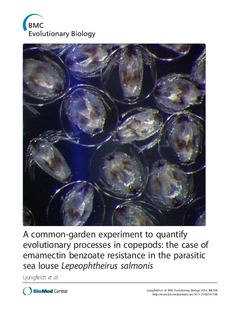| dc.contributor.author | Ljungfeldt, Lina | |
| dc.contributor.author | Espedal, Per Gunnar | |
| dc.contributor.author | Nilsen, Frank | |
| dc.contributor.author | Skern-Mauritzen, Mette | |
| dc.contributor.author | Glover, Kevin A. | |
| dc.date.accessioned | 2014-10-30T12:57:03Z | |
| dc.date.available | 2014-10-30T12:57:03Z | |
| dc.date.issued | 2014-05-19 | |
| dc.identifier.citation | Ljungfeldt LE, Espedal P, Nilsen F, Skern-Mauritzen M, Glover K: A common-garden experiment to quantify evolutionary processes in copepods: the case of emamectin benzoate resistance in the parasitic sea louse Lepeophtheirus salmonis. BMC Evolutionary Biology 2014, 14(1):108. DOI:10.1186/1471-2148-14-108 | nb_NO |
| dc.identifier.issn | 1471-2148 | |
| dc.identifier.uri | http://hdl.handle.net/11250/225132 | |
| dc.description.abstract | Background
The development of pesticide resistance represents a global challenge to food production. Specifically for the Atlantic salmon aquaculture industry, parasitic sea lice and their developing resistance to delousing chemicals is challenging production. In this study, seventeen full sibling families, established from three strains of Lepeophtheirus salmonis displaying differing backgrounds in emamectin benzoate (EB) tolerance were produced and quantitatively compared under a common-garden experimental design. Lice surviving to the preadult stage were then exposed to EB and finally identified through the application of DNA parentage testing.
Results
With the exception of two families (19 and 29%), survival from the infectious copepod to preadult stage was very similar among families (40-50%). In contrast, very large differences in survival following EB exposure were observed among the families (7.9-74%). Family survival post EB exposure was consistent with the EB tolerance characteristics of the strains from which they were established and no negative effect on infection success were detected in association with increased EB tolerance. Two of the lice families that displayed reduced sensitivity to EB were established from a commercial farm that had previously used this chemical. This demonstrates that resistant alleles were present on this farm even though the farm had not reported treatment failure.
Conclusions
To our knowledge, this represents the first study where families of any multi-cellular parasite have been established and compared in performance under communal rearing conditions in a common-garden experiment. The system performed in a predictable manner and permitted, for the first time, elucidation of quantitative traits among sea lice families. While this experiment concentrated on, and provided a unique insight into EB sensitivity among lice families, the experimental design represents a novel methodology to experimentally address both resistance development and other evolutionary questions in parasitic copepods. | nb_NO |
| dc.language.iso | eng | nb_NO |
| dc.publisher | BioMed Central | nb_NO |
| dc.rights | Navngivelse 3.0 Norge | * |
| dc.rights.uri | http://creativecommons.org/licenses/by/3.0/no/ | * |
| dc.title | A common-garden experiment to quantify evolutionary processes in copepods: the case of emamectin benzoate resistance in the parasitic sea louse Lepeophtheirus salmonis | nb_NO |
| dc.type | Journal article | nb_NO |
| dc.type | Peer reviewed | nb_NO |
| dc.subject.nsi | VDP::Agriculture and fishery disciplines: 900::Fisheries science: 920::Fish health: 923 | nb_NO |
| dc.source.pagenumber | 18 p. | nb_NO |
| dc.source.volume | 14 | nb_NO |
| dc.source.journal | BMC Evolutionary Biology | nb_NO |
| dc.source.issue | 1 | nb_NO |
| dc.identifier.doi | 10.1186/1471-2148-14-108 | |

